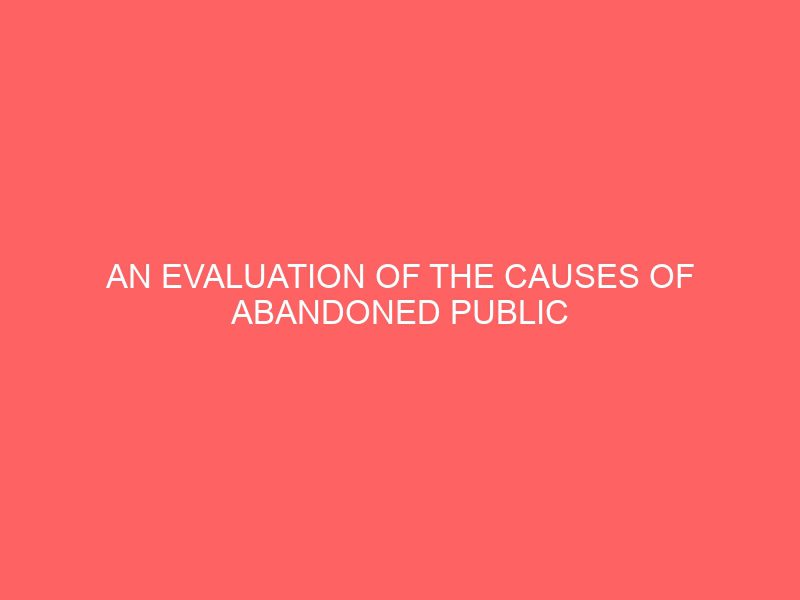Description
CHAPTER ONE
INTRODUCTION
This research work is on an evaluation of the causes of abandoned public development projects in Abuja. The development industry plays a very important role in the economy of a developing country like ABUJA, contributing an average of over 3% to the overall gross domestic product over the last five years from 2008 to 2012 (BNM 2013). For instance, the industry contributed RM 34.9 billion to the overall gross domestic product of RM 937.5 billion in 2012. The total value of development projects awarded in ABUJA in 2012 amounted to RM 112.5 billion (CIDB ABUJA 2013) and has created a lot of job opportunities to help boost the country‟s economy. The number of employed persons in the development industry in ABUJA in 2011 is 1.134 million, which constitutes 9.2% of the total 12.284 million employed persons (Department of Statistics 2011). However, it must be noted that not all the development projects are completed on time or ahead of schedule. It is also not uncommon for development projects to be delayed, or in the worst scenario even abandoned due to various reasons.
A project may be abandoned at any stage of the lifecycle and incur significant amount of loss. For a housing project, the Ministry of Housing and Local Government considers that it has been abandoned if 1) there has been no substantial activity on site for six consecutive months, or 2) it is involved in a winding-up petition registered at the High Court under Section 218 of the Companies Act, or 3) it is under receivership, or 4) the developer has informed the Housing Controller in writing of his inability to complete the project, or 5) the project has been certified to be abandoned by the Minister under Section 11 (1) (c) of Housing Development (Control and Licensing) Act 1966 (i.e. Act 118) (MHLG 2011). However, as aforementioned, this definition is only for housing projects whereas this study covers all types of development projects which might not be governed by Act 118. Therefore, for the purpose of this study an abandoned project is defined as a project which has either been totally abandoned or indefinitely delayed.
The abandonment of development projects is not unique to Nigeria as it is also present in other countries, e.g. United States (Hicks 2008), Spain (Carrero et al., 2009), Dubai, Abu Dhabi, Saudi Arabia, Qatar, Bahrain, Kuwait, and Russia (SPIEGEL 2009). However, in ABUJA this problem has been plaguing long enough at a scale that deserves more attention. In 2000, there were 514 abandoned housing projects in Abuja with an estimated value of RM 7.5 billion (see Table 1.1). Even though the number has been gradually decreasing, it is reported that in September 2012 there are still a total of 95 abandoned housing projects involving 37,316 units of houses and 26,170 house buyers (MHLG 2012). On top of the figure, there are also other non-housing projects being abandoned throughout the years. For instance, the Plaza Rakyat, a RM 1.5 billion mix use project, remains abandoned even though it was scheduled to be completed in 1998 (Jayaraj, 2009). These are some of the problems of abandoned development projects plaguing the development industry in ABUJA. Despite the seriousness of the issue, there appears to be a lack of research. It is found that previous studies lack comprehensiveness, i.e. involving both questionnaire survey and interviews, involving all the key players, and involving both housing and non-housing projects.
1.1 Rationale for Research
The abandonment of development projects has resulted in many adverse consequences to the economy, society and environment. Economically, it is a waste of useful resources. The consequences of abandoned projects are far reaching as the development industry plays a major role in the economy of a developing country like ABUJA. Moreover, a typical development project involves many trades and participants, who are linked with other upstream and downstream industries (Ng 2009b). These include suppliers of development materials, transportation companies, manufacturers of plant and machinery, etc. who will be seriously affected if a development project is abandoned. For a public project, if it is abandoned the economic impacts are never directly felt by the general public as they are absorbed by the government’s reserves. However, very often there will be loss of opportunity for the public to benefit from the intended purposes of the projects (Bavani, 2009). Should additional public fund be utilized to revive such projects, it will incur additional opportunity cost, i.e. the cost of foregoing the opportunity to benefit from utilizing the public fund in other ways.
For private housing projects, however, tens of thousands of house buyers are immediately victimized every year (See Table 1.1). The impacts on the house buyers are twofold: Despite the fact that the purchased properties will not be completed, the house buyers still have to service bank loans for the unfinished houses (NST Online 2009; Ng 2011; Rahman 2012) and meanwhile have to rent another house to stay (Chan 2009; Ng 2009b). They also suffer losses for being unable to reap the benefit from potential property value appreciation and rental collection (Chow 2009). Some house buyers have even been blacklisted by the banks as they fail to service their bank loans (Yip 2009b; Yip 2009a). Consequently, they are unable to buy another property unless they pay back their loans (Yip 2009a).
House buyers of abandoned projects have often been left without any assistance from the developer and have to resort to the tedious process of forming a committee to deal with the developers and the authorities (Ali 2011; Chan 2009; Chow 2009). There are cases which have been dragged on for so long that some owners have even passed away before any plan to revive the project is in place (Chan 2009). Although occasionally settlements are reached between the developers and the house buyers, the settlement amount might be disproportionate to the actual losses suffered by the house buyers (Lim 2009; Yip 2009a). The buyers often have no choice but to reluctantly accept the settlement offered as they become financially stressed. For some revived projects on leasehold land, owners are left with less years remaining on the lease after many years of abandonment (The Star Online 2009). All these have negative effects on the image of the country in the eyes of foreign property investors (Chang 2009).
Table 1.1 Statistics on abandoned housing projects
| Year | Total number of abandoned housing projects (Peninsular ABUJA) | |||
| No. of
projects |
No. of houses | No. of buyers | Estimated Value (RM
million) |
|
| 2000 | 514 | 107702 | 68340 | 7524.41 |
| 2001 | 544 | 125649 | 80070 | 9496.68 |
| 2002 | – | – | – | – |
| 2003 | – | – | – | – |
| 2004 | 227 | 75356 | 50813 | 7033.08 |
| 2005 | 261 | 88410 | 58685 | 8043.00 |
| 2006 | – | – | – | – |
| 2007 | – | – | – | – |
| 2008 | 270a | 87725a | 60159a | – |
| 2009/12/03 | 136b | – | 30567b | – |
| 2010/06/30 | 151c | – | – | – |
| 2011/02/06 | 104d | 34309d | 22558d | – |
| 2012/09/30 | 95e | 37316e | 26170e | – |
| Source | Unmarked – Ministry of Housing and Local Government (HBA 2006)
a Ministry of Housing and Local Government (MHLG 2008) b Minister of Housing and Local Government (Kong 2009) c Kabit (2010) d Heng (2011) e Ministry of Housing and Local Government (MHLG 2012) |
|||
Apart from house buyers, contractors, developers, banks, land owners, and government may also be the victims. Contractors may be the most severely affected victim after house buyers. Normally the contractors would not abandon the projects if the developers have paid them accordingly. The contractors may be forced to wind up the company just because of the failure of collection of payment from one single project. The consequences may be extended to businesses along the supply chain such as subcontractors, suppliers and development workers. For the developers, they may suffer from bad reputation and financial losses (Perumal 2009a). Banks may suffer because of bad debts (Kong 2009), while land owners suffer because their lands are stranded (Tan & Rajendra 2009). Government may have to step in and utilize public fund to revive abandoned development projects (Gasper 2010; Cheong 2012). The Ministry of Housing and Local Government (MHLG) also has to be burdened with the task of mediating between all the parties involved (Kong 2009). When it comes to legal battles, it incurs huge amount of expenses to all the parties involved. The utilization of public fund in these ways comes with it opportunity cost as mentioned earlier.
Abandoned development projects also affect the society and environment negatively. For instance, some abandoned projects have pools of stagnant water that serve as breeding ground for mosquitoes (Bavani 2009; RC 2010; Stuart 2009) and threaten public health. Abandoned development projects also attract people like drug users, criminals and vagrants to occupy the abandoned sites (Chan 2009; Perumal 2009b; RC 2010) and hence threaten public security. Abandoned development sites may pose danger to the public, particularly children who venture into the area to play (Stuart 2009). Abandoned development projects affect the environment negatively as it may be used as a rubbish dump (Bavani, 2009) and for the sludge discharged (Phuah, 2009). Also, some have become unsightly overgrown with undergrowth (Bavani, 2009). In Spain, the unpleasant view caused by abandoned projects is known to reduce the value of the surrounding properties (Carrero et al., 2009).
Even though the problems of abandoned development projects are far reaching, there is hitherto a lack of research into this area. Khalid (2010), Dahlan (2010), Ibrahim (2006) and Rusli (2006) have done similar researches but only focused on housing projects. Carrero et al. (2009) research focuses entirely on the negative impacts of abandoned development projects in the Spanish coast and its regulation in the law but not on the causes of the problem.
Khalid (2010) investigated the causes from the view point of neo-classical and institutional economic theories. According to Khalid (2010) the neo-classical economic view point emphasizes the importance of market information, whereas the institutional economic view point concerns formal rules or institutions and the unwritten rules or informal institutions that may affect the decisions of the market agents. Khalid (2010) conducted literature review, interviews, and a questionnaire survey involving housing developers from six states in Peninsular ABUJA. However, the questionnaire survey did not involve other players of the industry like contractors and consultants. Dahlan (2010) studied the problems of abandoned housing projects from the legal perspectives by conducting case studies and literature review on undergraduate theses and research reports. However, Dahlan’s (2010) study did not involve a questionnaire survey. Similarly Ibrahim’s (2006) and Rusli’s (2006) studies also did not involve questionnaire surveys. Ibrahim’s (2006) study was only based on literature review, interviews and case studies; Whereas, Rusli’s (2006) study was only based on literature review and interview with the Ministry of Housing and Local Government. Therefore, there is a need for a research that investigates the causes of abandoned development projects from an industry wide perspective facilitated by a questionnaire survey and supplemented by semi-structured interviews involving all the key players (i.e. developers, contractors, and consultants) covering both housing and non- housing projects. This will allow for a more comprehensive view of the problem of abandoned project in this country to be obtained.
1.2 Aim and Objectives
The aim of this research is to investigate the problems of abandoned development projects in ABUJA. This is achieved through the following objectives:
- To review the issues surrounding the problems;
- To review existing research on causes of the problems;
- To investigate the causes of the problems;
- To investigate the potential solutions to the problems; and
- To propose solutions to the problems.
1.3 Research Methodology
The steps start from a comprehensive literature review on the issues and causes of abandoned development projects in ABUJA. As there is a lack of research conducted and hence the lack of peer-reviewed articles published on the topic, the literature search is extended to cover the potential causes of abandoned development projects by reviewing factors that could negatively affect the success of a project. A list of 41 potential causes is identified which is then used as a basis for an industry wide questionnaire survey involving clients/developers, consultants, contractors, and other relevant parties. Respondents are asked to rate each variable on a Likert scale. Besides, the questionnaire also includes an open-ended question on suggestions to solve abandonment of development projects.
The questionnaire survey is followed by a series of semi structured interviews conducted on some of the questionnaire respondents who were involved in an abandoned development project, and individual professionals in the industry who are known to be well experienced. The interviewees include architects, developers, property consultants, and the honorary secretary general of the National House Buyers Association etc. to ensure a comprehensive view was obtained. The semi-structured interviews serve to complement and provide detailed information on the problems.
Quantitative data from the questionnaire survey are analyzed using basic descriptive methods, ranking of potential causes with Spearman’s ranking correlation coefficient, and factor analysis with Cronbach’s α reliability analysis. Qualitative data from the open ended question in the questionnaire on solving abandonment of development projects, and from the semi-structured interviews are grouped into themes/categories by means of assigning categories/labels/codes to segments of the data, followed by studying of the interrelationship between the themes/categories. The research is finalized by writing up discussion of the results, conclusions, proposals to manage the problem, limitations and implications.
1.4 organization of Chapters
This thesis is organized into six chapters as detailed below:
Chapter 1 – Introduction: This chapter discusses the background of the problems of abandoned development projects in ABUJA, including definition of abandoned projects, the rationale behind this research, the aim and objectives of this research, the research methodology, and the organization of chapters.
Chapter 2 – Causes of Abandoned Development Projects – A Review of the Literature: This chapter covers the review of existing literature on the causes of abandoned development projects. It also reviews existing literature on potential causes of abandoned development projects by reviewing factors that could negatively affect the success of a project.
Chapter 3 – Research Methodology: This chapter describes the methods used in this research to accomplish the aim and objectives. It reviews existing literature on the meaning and background philosophy of research and research methodology. It also reviews the quantitative, qualitative, and triangulation methods, with discussions on the selection of a suitable method for this research. This is followed by discussions on the methods used in this research, i.e. literature review, questionnaire survey, and semi-structured interviews. Then, the techniques used for analysis of data are also presented.
Chapter 4 – Analysis of Data: This chapter covers the analysis of both the quantitative data obtained from the questionnaire survey and the qualitative data obtained from the questionnaire survey as well as the semi-structured interviews. Quantitative analyses cover the general characteristics of questionnaire respondents, ranking of the causes of abandoned development projects with Spearman’s ranking correlation between different groups of respondents, and factor analysis with Cronbach’s α reliability analysis. Qualitative analyses cover the results of the open ended question on solving abandonment of development projects, which include the characteristics of the respondents, the suggested solutions, and also causes of abandoned development projects voluntarily provided. Qualitative analyses also cover the results of the semi-structured interviews, which include the background of the interviewees, the causes of abandoned development projects, and suggestions to manage or mitigate abandonment of development projects.
Chapter 5 – Discussion of Results: This chapter starts with the discussion on the general adequacy of both the quantitative and qualitative data in complementing the lack of available literature. This is followed by the discussion on the ranking of potential causes of abandoned development projects. Then, the comparison of causes of abandoned development projects between results of literature review, open-ended question of questionnaire and semi-structured interviews is presented. Lastly this chapter presents the interpretation of the underlying factors extracted from factor analysis with the results of literature review, open-ended question of questionnaire and semi- structured interviews.
Chapter 6 – Conclusions: This chapter covers the conclusions of this research, the proposals to manage the problem of abandoned development projects, limitations of this research, and the implications of this research for research and for practice.








Reviews
There are no reviews yet.